
- Index
- Age
- 16th Century (3)
- 1736-1795 (6)
- 17th Century (4)
- 1800-1849 (100)
- 1850-1899 (335)
- 1861-1875 (6)
- 18th Century (18)
- 1900-1940 (195)
- 1950-1970 (4)
- 19th Century (22)
- 20th Century (10)
- 960-1279 (10)
- 960年—1279年 (11)
- Post-1940 (138)
- Post-1950 (4)
- Pre-1800 (479)
- Qing Dynasty (11)
- Unknown (327)
- 1600 (5)
- 1850 (4)
- ... (3191)
- Chinese Dynasty
- Features
- Maker
- Antique (3)
- China (60)
- Chinese (44)
- Chinese Artist (3)
- Chinese Export (10)
- Famille Rose (5)
- Handmade (3)
- Jingdezhen (14)
- Kangxi (3)
- Kangxi (1661-1722) (5)
- Longquan (4)
- Ming Dynasty (3)
- Qianlong (4)
- Qianlong (1735-1796) (9)
- Qing (4)
- Qing Dynasty (10)
- Signed (10)
- Unknown (76)
- Unsigned (4)
- Wan Li (3)
- ... (4606)
- Product
- Type
A FAMILLIE VERTE CHINESE PORCELAIN PLAQUE LANDSCAPE 1950´s
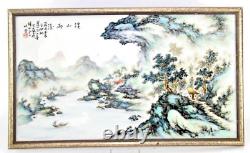
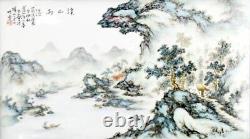
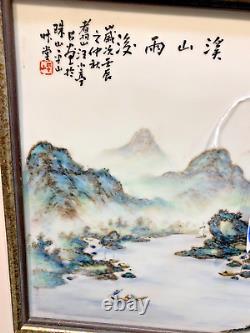
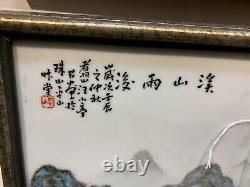
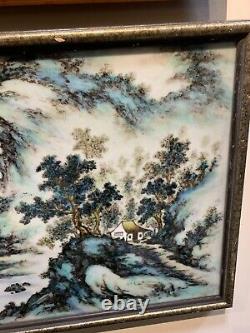
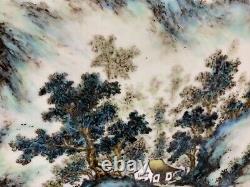




A FAMILLIE VERTE CHINESE PORCELAIN PLAQUE. Measures 33 cm x 53 cm approximately. Measuring 13 inches in height and 21 inches in width (33 cm x 53 cm), this stunning Chinese porcelain plaque provides a breathtaking view of a serene landscape. The horizontal format of the plaque allows the artist to present an expansive vista, capturing the beauty and tranquility of the natural world in exquisite detail. The plaque's dimensions lend themselves perfectly to the portrayal of the panoramic scene, with the lush vegetation extending across the entire width of the composition.
The ample space allows the artist to meticulously render the flora and fauna in a way that invites the viewer to explore the scene further. The lake, which occupies a significant portion of the plaque, creates a sense of depth and distance, drawing the eye to the far reaches of the landscape. The boat, although small in comparison to the overall scene, provides a focal point that adds a human element to the otherwise idyllic natural setting. The use of the 13" H x 21" W format for the porcelain plaque showcases the adaptability and innovation of Republican Era artists. This format not only highlights their mastery of traditional techniques but also demonstrates their ability to expand the boundaries of their craft, resulting in striking and memorable works of art.
A unique and artistic expression of Chinese craftsmanship, has captured the hearts and imaginations of art connoisseurs, collectors, and enthusiasts across the world. Known for its delicate and intricate design, as well as its diverse color palette featuring various shades of green, Famille Verte porcelain has come to symbolize Chinese artistry and cultural heritage. This essay will delve into the historical background, production process, and the cultural significance of this exquisite art form. The development of Famille Verte porcelain can be traced back to the Kangxi period, which saw a resurgence in the production of fine porcelain after the turmoil of the Ming-Qing transition. During this time, Chinese artisans were eager to revive and innovate traditional techniques in response to the emperor's patronage and the growing demand for exquisite art pieces. Famille Verte emerged as an evolution from the earlier Wucai (five-color) and Doucai (contrasting colors) techniques, as artists began to experiment with new pigments and firing methods to create a richer color palette and more sophisticated designs. Famille Verte porcelain is characterized by its intricate designs and vivid colors, particularly the varying shades of green that lend the art form its name. The production process involves several stages, starting with the creation of the porcelain body using kaolin and petuntse, two primary ingredients in Chinese porcelain. The body is then shaped, either by hand or using a potter's wheel, and fired at high temperatures to create a strong, translucent white base. The decoration process begins with the application of outlines using a fine brush dipped in a mixture of cobalt oxide and water. This stage requires immense skill and precision, as any mistakes are difficult to rectify once the piece is fired. After the outlines are set, artisans fill in the designs with enamel colors, including various shades of green, yellow, red, blue, and black.These enamel pigments are made from minerals that are ground into a fine powder, mixed with water and a binding agent, and then applied to the porcelain surface. The final step in the production process is the firing of the porcelain in a muffle kiln, which allows for precise temperature control. The enamel colors fuse with the porcelain body during this stage, creating the vibrant and enduring designs that have become synonymous with Famille Verte. Famille Verte porcelain is a testament to the skill and creativity of Chinese artisans during the Kangxi period.
The refined and intricate designs, often depicting scenes from Chinese history, mythology, and nature, reflect the cultural values and aesthetics of the time. As such, these exquisite pieces have come to symbolize the richness and depth of Chinese cultural heritage. As trade relations between China and Europe flourished in the 17th and 18th centuries, Famille Verte porcelain became highly sought after by European collectors and aristocrats, leading to a growing fascination with Chinese art and culture. This fascination, in turn, contributed to the development of Chinoiserie, a European artistic movement inspired by Chinese art, which further elevated the cultural significance of Famille Verte porcelain. Chinese Famille Verte porcelain is an exquisite and timeless representation of Chinese artistry and cultural heritage.With its intricate designs and vibrant colors, it stands as a testament to the skill and creativity of the artisans during. This item is in the category "Antiques\Asian Antiques\China\Vases".
The seller is "themarcopologallery" and is located in this country: BR. This item can be shipped worldwide.
- Primary Material: Porcelain & Pottery
- Color: Multi-Color
- Original/Reproduction: Vintage Original
- Region of Origin: China
- Age: Post-1940

